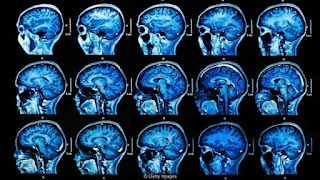Transverse Myelitis
Overview
Transverse myelitis is a neurological disorder caused by
inflammation (swelling) across both sides of one level or segment of the spinal
cord. Inflammation can damage or destroy myelin, the fatty protective substance
that covers nerve cell fibers. This damage causes scars that interrupt the
communication between the nerves in the spinal cord and the rest of the body.
Most people affected by transverse myelitis will have only one attack; a small
percentage may have more than one attack.
Transverse myelitis can appear as the first symptom in
conditions such as multiple sclerosis (MS) or neuromyelitis optica (NMO). A
person with transverse myelitis who also has an abnormal brain MRI with more
than two lesions has an increased chance (as high as 90 percent) of going on to
develop MS.
What causes transverse myelitis?
The exact cause of the damage to the spinal cord has not yet
been determined with certainty but it is thought that it may be due to an
autoimmune reaction to a viral or bacterial infection. In autoimmune diseases,
the immune system mistakes the body’s own tissue as foreign, and attacks it,
causing inflammation (swelling) that results in damage to the myelin.
An infection precedes the onset of transverse myelitis about
50% of the time.
- Transverse myelitis often develops following viral infections such as varicella zoster (the virus that causes chicken pox and shingles), herpes simplex, cytomegalovirus, Epstein-Barr, influenza, echovirus, HIV, hepatitis A, and rubella.
- Bacterial skin infections, otitis media (middle-ear infections) and Mycoplasma pneumonia (bacterial pneumonia) have been associated with transverse myelitis.
Some cancers may trigger an abnormal immune response that my
lead to transverse myelitis.
Who gets transverse myelitis, and when?
Transverse myelitis occurs in adults and children, in males
and females and in all races.
- Females have a higher risk of transverse myelitis than males.
- No genetic pattern is known. Transverse myelitis is not related to family history.
- The highest number of new cases in a given year occur between age 10 and 19 and between age 30 and 39 years.
- The symptoms of transverse myelitis can appear suddenly, developing over hours to several days or more gradually developing over a period of 1 to 4 weeks.
It is estimated that about 1,400 new cases of transversemyelitis are diagnosed each year in the United States. It is estimated that
about 33,000 Americans have some type of disability resulting from transverse
myelitis.
The annual incidence of transverse myelitis ranges from 1.34
to 4.60 cases per million, but increases to 24.6 cases per million if acquired
demyelinating diseases like MS and neuromyelitis optica (NMO) are included.
#Alzheimers2018 will be a great platform for researchers from the field of Neurodegenerative Disorders to present their work.. Submit your abstracts to be a part of the Global Event via: https://bit.ly/2HlLuhx




Comments
Post a Comment